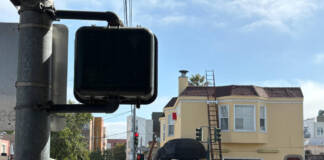
by Ahimsa Porter Sumchai, M.D.
Dear City Star Editors,
I read with interest the Dec. 20, 2007 article announcing the federal government procurement of $82 million dollars towards the cleanup of the Hunters Point Shipyard. In 2001, as an elected member of the shipyards Restoration Advisory Board, I founded its Radiological subcommittee and published comments on its cleanup in federal documents and local media. I applaud all efforts to hasten the thorough cleanup of the toxic property in keeping with standards protective of human health. The shipyard has been classified by the EPA as a Superfund site and represents one of the most contaminated pieces of urban property in the United States. Navy and public records show that radioactive wastes, toxic heavy metals, PCB’s and other pollutants are disposed of on this site.
The public must be apprised of the fact that the Conceptual Framework for development for Candlestick Point and parcels A-3 and B-E of the Hunters Point Shipyard adopted as Resolution No. 59-07 by the Board of Supervisors on Feb. 13, 2007, documents in its preliminary hazardous materials remediation plan that “to date the Navy has spent almost $500 million on remediation of the shipyard and may need to spend at least that much money or more to finish the job.”
Additionally, on Nov. 7, 2000, 86 percent of the San Francisco electorate voted in support of Proposition P calling for the cleanup of the shipyard to residential standards to protect future residents from exposure to toxic chemicals through contact with soil, water and air. This proposition was codified as an ordinance by the Board of Supervisors in May of 2001 and signed into law by then Mayor Willie Brown. Efforts to “dirty transfer” uncleaned shipyard parcels as proposed in the conceptual plan and the June 2008 ballot measure represent a direct violation of a city ordinance.
The U.S. Navy, in its Dec. 6, 2007 Radiological Program Update, documents its designation of “Parcel 49” within Parcel D of the shipyard as a potential site for stadium development. This is a parcel with buildings and soils contaminated with low level radioactive materials. The EPA Ionizing Radiation Series identifies the health effects of low level ionizing radiation to be genetic effects, cancer, precancerous lesions, benign tumors, cataracts, skin changes and congenital defects.
Ahimsa Porter Sumchai, M.D., Health and Environmental Science Editor San Francisco Bay View Newspaper, Attending Physician Persian Gulf, Agent Orange, Ionizing Radiation, Registry Palo Alto Veterans Administration Hospital 1997-2000.





